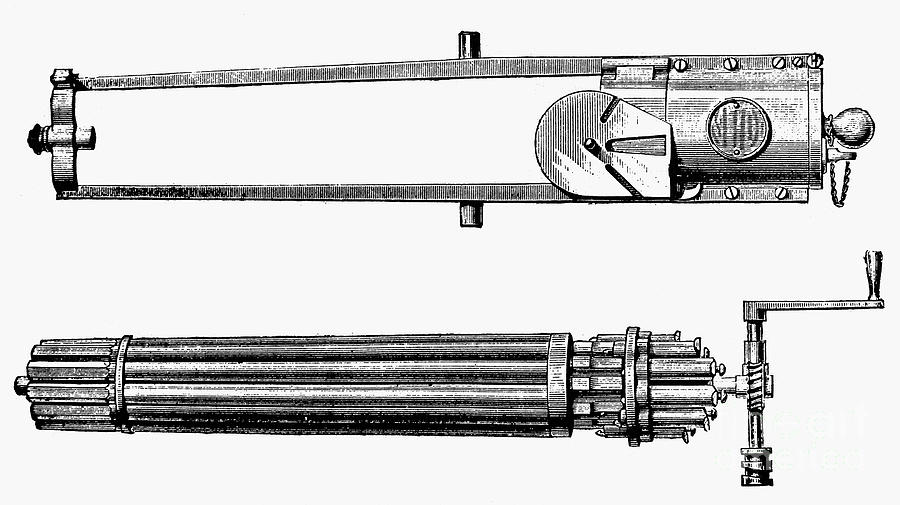
1874 Gatling Gun Blueprints Weapon
Silva 1/22/2018 • Their mere presence was enough to scare off most challengers. G atling gun. The name is nearly as recognizable to Old West aficionados as Colt, Winchester, Remington or Smith & Wesson, and it certainly triggers the imagination as much as any frontier gun.
Home Machine Guns Manual machine guns Shooting an 1877 Bulldog Gatling Shooting an 1877 Bulldog Gatling. Thanks to an interesting quirk of US gun laws, the. The Gatling Gun is interested for. Which were located centrally on the gun. In 1874 this arrangement. There is a header called “Gatling Gun Blueprints”. THE GATLING (' Gij N. Gatling gun consists of a series of barrels grouped around and parallel to a common shaft or axis, aboLlt wilich.
In reality, though, this revolving-barreled forerunner of the machine gun was seldom used in the West. The Gatling’s reputation for dealing death rapid-fire was so intimidating that the gun’s presence at a crucial showdown, either civilian or military, usually sent opponents scurrying without a shot being fired.

Richard Jordan Gatling, born in Maneys Neck, N.C., on September 12, 1818, made a name for himself and a small fortune long before his groundbreaking gun came to his innovative mind. In 1839 he invented an award-winning, seed-sowing “wheat drill” that mechanized seed planting. After almost dying from smallpox in 1846, Gatling decided to study medicine, and from that time on he was known as Dr. He tested the first Gatling gun prototype in 1861, after the Civil War broke out. As he explained in a June 15, 1877, letter to a friend, the lone man who fired the gun could replace 100 men with rifles, thereby greatly reducing the number of men who might otherwise be exposed to enemy fire on the battlefield.
The Gatling gun features a revolver-like grouping of gun barrels, a top-mounted magazine and a breech-mounted hand crank. A gunner rotates the crank to feed cartridges into the rear of the barrels. The only limit to the rate of fire is how many cartridges are in the magazine and how fast a gunner can turn the crank. Early Gatling guns could spit out some 200 rounds per minute, though each magazine held just 20 rounds and had to be hastily replaced when empty. The later donut-shaped Accles drum magazine held 104 rounds, while the Broadwell drum, which rotated horizontally atop the breech, held a cluster of twenty 20-round vertical magazines, for a 400-round capacity.
Gatling designed his first models with exposed barrels, but when Colt began manufacturing the guns in 1867, many included cylindrical bronze casings to protect the barrels and mechanism from dust and weather. Gatling was perpetually redesigning the mechanism, the number of barrels ranging from 5 to 10. Over the years, Gatling guns ranged in size from half-ton versions on cannon carriages to the little five-barreled.45-70 Model 1877 Bulldog that weighed just 90 pounds but could fire an astounding 1,000 rounds per minute. As cartridges became more and more standardized, available Gatling-gun calibers ranged from.58 rimfire to.50-70 to 1-inch,.42,.45-70 Government,.30-40 Krag,.30-03 Springfield and.30-06 centerfire. “Most Western Army posts of any size were equipped with Gatling guns, and a number were taken on campaigns,” writes military firearms historian Lee Rutledge in his forthcoming book, Stop the Repeaters: The U.S. Army’s Struggle to Adopt a Repeating Rifle, 1813–1903.
Optical beta font download. In his 2005 book Gunsmoke and Saddle Leather, Old West firearms historian Charles G. Worman writes: “On August 30 [1874] on the ‘staked plains’ of west Texas, Lieutenant John Pope of the 5th Infantry used two Gatling guns to break up an ambush set for Colonel Nelson Miles’ force. Another column under Miles, this one led by Major William Price of the 8th Cavalry, also employed Gatling guns. One of Price’s officers later wrote that on one occasion Price’s force ‘was attacked by 600 or 700 Indians, and he used his Gatlings with such excellent effect as to quite demoralize and drive off his savage assailants.’” Worman also quotes an 1875 witness to a U.S.
Expedition on the Yellowstone River that mounted a Gatling gun on the deck of the steamer Josephine: “This was a beautiful arm and, when placed in position on the boiler deck of the boat, was enough to strike terror to the hearts of any Indians we might run against, as being ‘bad medicine’ for them.” In Nebraska during the winter of 1878– 79, rancher/sheriff Ira Olive (brother of the notorious Print Olive) murdered two homesteaders and faced trial. “The courthouse” writes Worman “was rapidly being overrun by desperadoes and tough-looking cowboys, all packing six-shooters.” If Olive was convicted, the cowboys figured to shoot up the courtroom. The judge called in the nearby 9th Infantry. One witness reported that the soldiers “deployed upon a vacant block diagonally across from the courthouse, ammunition was passed out, and the Gatling gun squad stood ready for action.” The cowboys took note. “I never saw so surprised and so quiet a crowd of menas those cowboys were,” the witness said. “Trouble was all over.” Manufacturers also sold Gatling guns to civilians and local governments and police departments in the West.